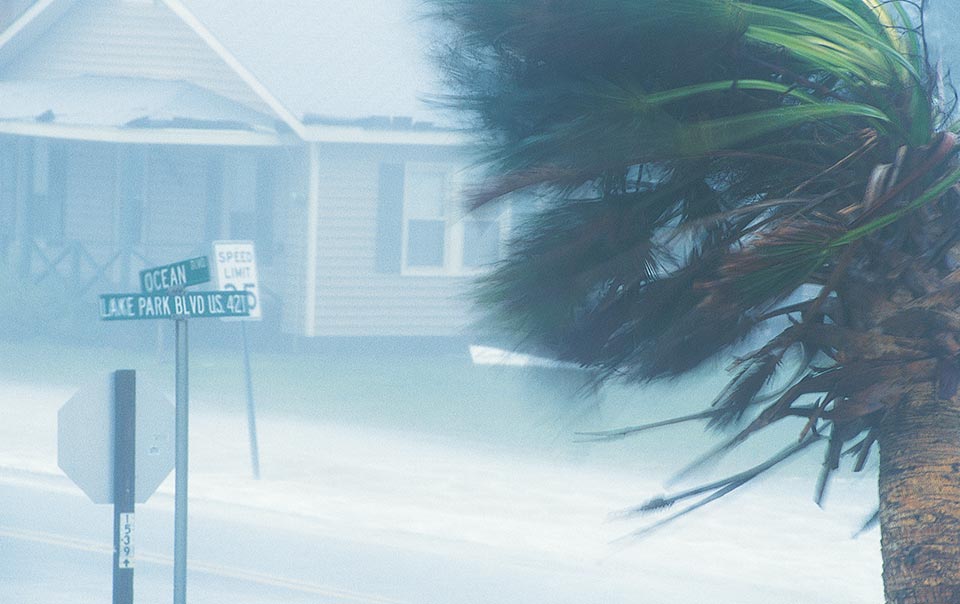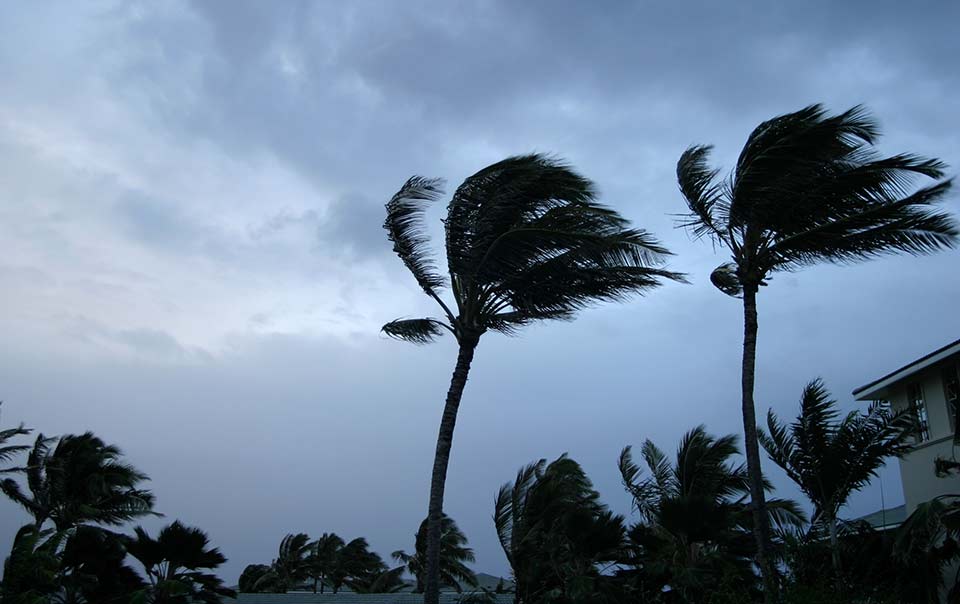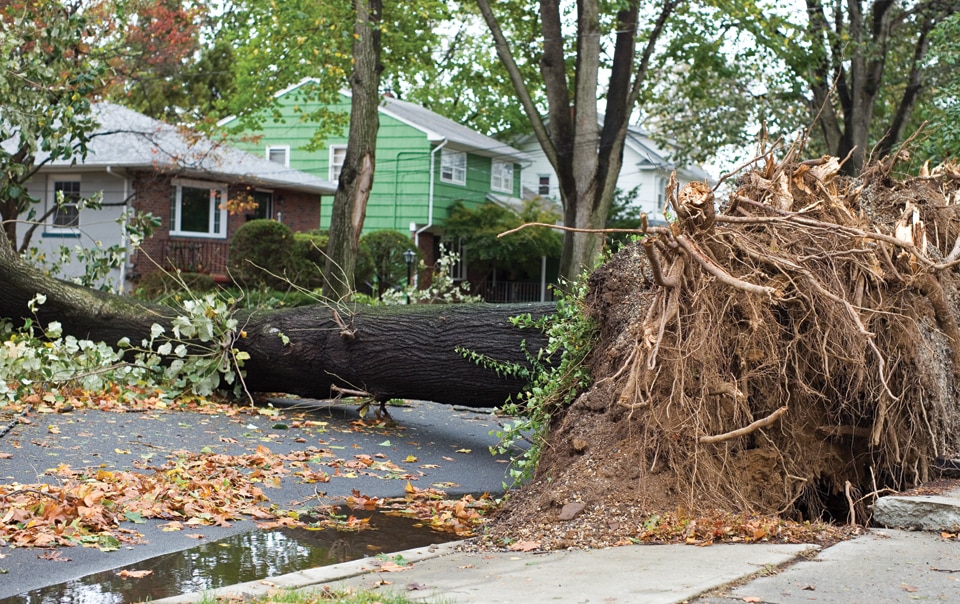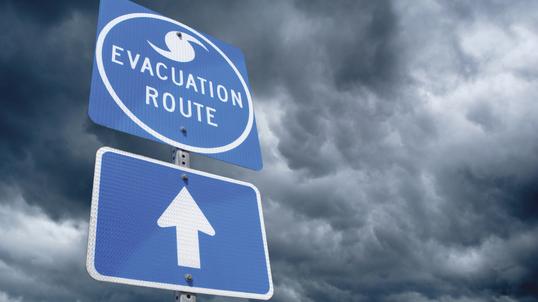How to Help Prepare for a Hurricane

(SPEECH)
[UPBEAT MUSIC]
(DESCRIPTION)
This content is brought to you by Travelers. The Travelers umbrella logo appears. Text, HOW TO HELP PREPARE FOR A HURRICANE.
(SPEECH)
SPEAKER: Preventing hurricane damage begins well before the storm. Here are five tips to help protect your home. Avoid water damage by closing and locking all doors and windows and removing window air conditioners.
(DESCRIPTION)
Cartoon homes sit along a neighborhood street in a red and gray scene. In an icon above one home, a door closes, and an air conditioner disappears from a window, allowing it to close.
(SPEECH)
Don't forget to clear your gutters and downspouts.
(DESCRIPTION)
Leaves flow out of a red gutter along a roof.
(SPEECH)
Monitor your trees, especially ones with limbs within 10 feet of your home, and routinely check for and prune cracked, split, or dead limbs.
(DESCRIPTION)
A magnification of a tree limb appears over a tree to the left of the home. Sheers prune a branch from the tree.
(SPEECH)
Protect roofs doors, windows, and skylights, and reinforce them wherever necessary.
(DESCRIPTION)
In an icon, a window shutter closes. Shutters sit closed over every window of the house.
(SPEECH)
Secure outdoor items. If you own a gas grill, it should be secured outside, rather than in a building.
(DESCRIPTION)
On the back deck of the home, a ratchet strap secures an outdoor table to the deck rail. Two more straps secure a grill to the opposite rail.
(SPEECH)
If you think your home was not built to current wind standards and might need reinforcing, contact someone who knows how to help you. Learn more about how to prepare and protect your home on travelers.com.
(DESCRIPTION)
A red pickup truck that reads, Contractor, pulls up outside the home. Text, VISIT TRAVELERS DOT COM. HOW TO HELP PREPARE FOR A HURRICANE. Copyright 2017 The Travelers Indemnity Company. All rights reserved. Travelers and the Travelers Umbrella logo are registered trademarks of The Travelers Indemnity Company in the U.S. and other countries.
Your level of preparation before a hurricane can have a significant impact on how well you weather the storm and how quickly you recover from it. Consider preparing your home, inside and out, long before a storm is in the forecast. In the end, you can never be too prepared when it comes to protecting your loved ones and your property from hurricanes and other extreme weather events.
Know the forecast
You may hear the terms "Hurricane Watch" and "Hurricane Warning" in your local forecast. Understanding the difference between them is essential to helping you prepare for a hurricane. As soon as a Hurricane Watch or Hurricane Warning is forecast for your area, it is important, depending on the type of alert, to immediately begin or complete your preparations.
A Hurricane Watch means hurricane conditions are possible within 48 hours. Begin stocking up on emergency supplies in the event a warning is issued. If you live in a coastal area, you also should be prepared to evacuate.
A Hurricane Warning is more serious. Hurricane-force winds (74 mph or higher) are expected to hit your area within 36 hours. Seek shelter or evacuate, if notified to do so.
General hurricane preparation tips
- Prepare a survival kit that includes items such as water, nonperishable food and medications for everyone, including your pets; a portable radio; flashlights; batteries; and battery chargers for your cellphones and other portable electronic devices, which can be powered by your car.
- Plan your evacuation route and leave as soon as an evacuation order is issued. Also, fuel up your car before you leave.
- Build a content inventory of the items in your home or at your business.
- Secure all outdoor objects or move them inside. Close your home’s storm shutters and board up windows and glass doors as appropriate.
- If possible, bring in gas or charcoal grills, but do not use them indoors. Also, do not store propane tanks inside the house or garage. Chain propane tanks in an upright position to a secure object away from your home.
- Secure your boat or move it to a safer place.
- Fill your emergency generator fuel tank, if you have one, and have spare fuel on hand. Store generator fuel in an approved container in a garage or shed, away from open flames, heat sources and appliances such as natural gas appliances.
Keep Track with Our Emergency Checklist
Five tips to help prepare your home for a hurricane
1. Help avoid water damage
Heavy rains have the potential to cause significant water damage. These tips can help you prepare your home.
- Close and lock all windows and doors and remove any window air conditioners.
- Remove valuable items from your basement or elevate them off of the floor.
- Clear debris from exterior drains and gutters.
- Repair damaged gutters and downspouts to make sure water can drain away from your foundation.
- Check your sump pump and the battery backup to confirm they are working properly.
2. Monitor your trees
In a powerful windstorm, trees can be a hazard. Broken limbs or fallen trees – even uprooted shrubbery – could damage your home and fences, or your neighbor's property.
Routinely maintain the trees around your home:
- Prune tree limbs within 10 feet of your home.
- Check for cracking or splitting in trees.
- Remove dead limbs and weakened trees.
3. Roofs, doors, windows and skylights
It is important to keep wall openings such as doors, windows and skylights protected. The roof, doors and windows of your house are especially vulnerable to wind damage. When houses are exposed to hurricane-force winds, roofs are most susceptible to damage, followed by walls and openings such as skylights.
Strengthen doors and windows by:
- Installing reinforcing bolt kits at the top and bottom of doors.
- Reinforcing garage doors.
- Installing storm shutters over windows.
4. Secure outdoor Items
If you live in an area that experiences high winds, outdoor items around your property that are not properly anchored can become airborne and cause damage.
- If high winds are expected in your area, move as many outdoor items indoors well before the high winds arrive. As mentioned earlier, do not store propane tanks in your home or garage.
- Adequately secure any remaining outdoor items that cannot be safely moved to protected areas.
5. Strengthen your exterior structure
During a windstorm, wind forces are carried from the roof down to the exterior walls and then to the foundation. Homes can be damaged when wind and wind-driven water get under the building’s exterior walls if proper controls are not in place.
Strengthen exteriors by employing a contractor to:
- Install hurricane straps to reinforce roof-to-wall and wall-to-foundation connections.
- Retrofit soffits to help ensure they remain in place in high winds.
- Properly brace roof trusses.




